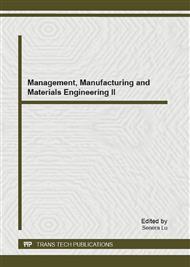[1]
Yang B and Salant, R.F., in: Elastohydrodynamic lubrication simulation of O-ring and U-cup hydraulic seals. Proc. IMechE, Part J: J. Engineering Tribology, 2011, 225, 603-610.
DOI: 10.1177/1350650110397236
Google Scholar
[2]
Nau, B.S., in: An historical review of studies of polymeric seals in reciprocating hydraulic systems. Proc. IMechE, Part J: J. Engineering Tribology, 1999, 213, 213–226.
DOI: 10.1243/1350650991542956
Google Scholar
[3]
Nikas, G.K., in: Eighty years of research on hydraulic reciprocating seals: review of tribological studies and related topics since the 1930s. Proc. IMechE, Part J: J. Engineering Tribology, 2010, 224, 1–23.
DOI: 10.1243/13506501jet607
Google Scholar
[4]
Muller, H.K. and Nau, B.S., in: Fluid sealing technology. New York: Marcel Dekker, (1998).
Google Scholar
[5]
Nau, B.S., in: An historical review of studies of polymeric seals in reciprocating hydraulic systems. Proc. IMechE, 1999, 213, 215–226.
Google Scholar
[6]
Stanislaw Stupkiewicz and Artur Marciniszyn, in: Elastohydrodynamic lubrication and finite configuration changes in reciprocating elastomeric seals. Tribology International, 2009, 42, 615–627.
DOI: 10.1016/j.triboint.2008.08.008
Google Scholar
[7]
Brunetiere, N., in: An analytical approach of the thermoelastohydrodynamic behavior of mechanical face seals operating in mixed lubrication. Proc. IMechE, Part J: J. Engineering Tribology, 2010, 224, 1221-1233.
DOI: 10.1243/13506501jet831
Google Scholar
[8]
Fatu, A. and Hajjam, M., in: Numerical modeling of hydraulic seals by inverse lubrication theory. Proc. IMechE, Part J: J. Engineering Tribology, 2011, 225, 1159-1173.
DOI: 10.1177/1350650111417046
Google Scholar
[9]
Nandor Bekesi, Karoly Varadi and David Felhos, in: Wear Simulation of a Reciprocating Seal. Journal of Tribology, 2011, 133, 031601-1-6.
Google Scholar
[10]
Ye Zibo, Huang Xing and Liang Rongguang, in: Sealing Performance and Wear Mechanism of PTFE Oil Seal. Technical Sessions-Proceedings of CIST2008 & ITS-IFToMM2008, 2008, 287-291.
DOI: 10.1007/978-3-642-03653-8_90
Google Scholar
[11]
Karger-Kocsis J., Mousa, A., Major, Z., and Bekesi, N., in: Dry Friction and Sliding Wear of EPDM Rubbers against Steel as a Function of Carbon Black Content. Wear, 2008, 264, 359–367.
DOI: 10.1016/j.wear.2007.03.021
Google Scholar
[12]
Archard, J.F., in: Contact and Rubbing of Flat Surface. J. Appl. Phys, 1953, 24, 981–988.
Google Scholar
[13]
Bekesi, N. and Varadi, K., in: 2009, Experimental and Numerical Evaluation of Lubricated Friction of EPDM Rubber. Proc. IMechE, 2009, 53, 69–73.
Google Scholar


